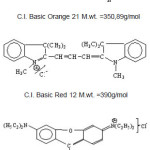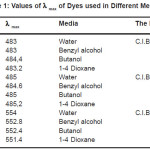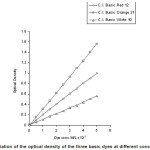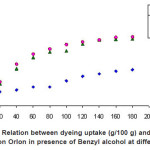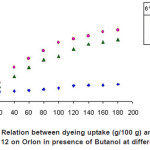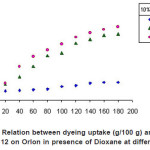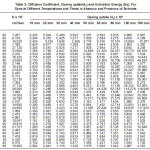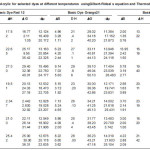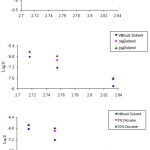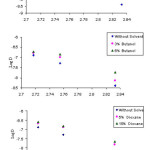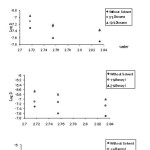Kinetic and Thermodynamic Analysis Study of the Dyeing Process of Acrylic Fabrics With Basic Dyes in Presence of Organic Solvents
M. El. Batouti1, N. F. Al Harby2, and A. M. Gamal3
1Department of Chemistry, Faculty of Science, Alexandria University, India.
2Department of Chemistry, Faculty of Science and Arts, Al Qassim University, India.
3Department of Chemistry, Faculty of Science, Al Azhar Girls University, India.
DOI : http://dx.doi.org/10.13005/msri/070103
Article Publishing History
Article Received on : 24 Mar 2010
Article Accepted on : 28 Apr 2010
Article Published :
Plagiarism Check: No
Article Metrics
ABSTRACT:
Kinetic and thermodynamic analysis of the dyeing process of acrylic fibers (Orlon) with basic dyes in the presence of small amounts of the solvents benzyl alcohol, butanol and 1-4 Dioxane are described in the present work. The dyeing affinity was measured using Gilbert and Rideal?s equation. Results show a close affinity on dye structure. The effect of increasing the dyeing temperatures from 80 to 95 oC as well as increasing the dyeing time over a range from 10 minutes to180 minutes was studied. Changes of enthalpy and entropy related to the process of absorption are calculated. The best thermodynamic conditions for dye uptake by acrylic fibers appear at the highest temperatures, when the standard free energy of absorption takes the most positive values. The mechanism of dye interaction with the fiber has been briefly considered. From the results, we find that the absorption of dye by acrylic fibers in the temperature interval investigated takes place with establishment of chemical bonds, although physical contributions of electrostatic nature between both the dye and the available sites in the fiber.
KEYWORDS:
Basic dyes; Acrylic fibers; Thermodynamic parameters; Kinetic
Copy the following to cite this article:
Batouti M. EI, Al Harby N. F, Gamal A. M. Kinetic and Thermodynamic Analysis Study of the Dyeing Process of Acrylic Fabrics With Basic Dyes in Presence of Organic Solvents. Mat.Sci.Res.India;7(1)
|
Copy the following to cite this URL:
Batouti M. EI, Al Harby N. F, Gamal A. M. Kinetic and Thermodynamic Analysis Study of the Dyeing Process of Acrylic Fabrics With Basic Dyes in Presence of Organic Solvents. Mat.Sci.Res.India;7(1). Available from: http://www.materialsciencejournal.org/?p=2210
|
Introduction
Acrylic fiber is one of the important fibers which have been dominating the textile field because of its superior quality like light weight, soft feel and warmth retaining characteristics.1 Cationic dyes can readily be applied to acrylic fibers and adsorbed by acrylic fibers to give Langmuir type of isotherms.2 The dyes are bonded to the acidic or anionic sites present in the fiber. The number of such sites vary from fiber to fiber depending upon the acidic groups available and generally limited.3 The acrylic fiber-dye system is characterized by its high sensitivity, both the composition and the morphology of the fiber must be taken into account because of their influence on the kinetic and equilibrium states of the system. This sensitivity and differences in dyeing behavior, together with the lack of published information on the composition of fibers, makes the study of the relation between the dyeing properties and the fiber composition and structure very difficult. Further, the morphology of acrylic fibers precludes treatment of the diffusion phenomena on a simple mathematical basis.
It is always important to dye acrylic fibers with (a) shortest possible dyeing time, (b)lowest cost of dyestuffs and auxiliaries and (c) levelness of dyeing.4
Basic dyes comprise compounds varying widely in chemical composition. Among these most widely used are triarylmethine and azoic dyes, keto-imine also find application.5 To find out the suitable pH for dyeing, two different pH were chosen (pH4 and pH7.5) the rate of uptake was found to be slightly higher in the case of pH7.5 [6]. At a suitable pH value, the species are present as cations as they have a quaternary nitrogen bearing a positive charge delocalized into a quinonide structure. The anion of basic dyes is usually a chloride anion which makes the basic dye water soluble. Basic dyes are characterized by their brilliance and intense hues as these compounds contain at least one of each chromphores and auxochromes groups. These dyes also used for dyeing acrylic fabrics.5
Acrylic fabric often shows difficulties in producing penetrative dyeings. By incorporating some solvents in the dyebath, it is possible to get deeper shades[6]. Studies on solvent treatment of synthetic fabrics like polyester and polyamide reveal that by suitable choice of a solvent, the chemical structure of the fabric can be modified in order to effect an increase in the dyeability. Also in the case of acrylic fabrics certain solvents bring about the structural changes which are reflected in the increase of the dye uptake.6
In the present work, different solvents, benzyl alcohol, butanol and 1-4 dioxane were used in the dyebath containing basic dyestuffs and acrylic fabrics to improve the fabric dyeability. Our aim is to establish kinetic relations and investigate the thermodynamics of sorption equilibria of basic dyes on Orlon at different temperatures, with the idea of improving subsequent dye uptake on Orlon. In addition to the earlier kinetic studies, this knowledge is absolutely necessary for a better understanding of interactions in the acrylic fiber/ dyes system.
Chemicals
The chemicals used in the present investigation were; (i)acid such as glacial acetic acid. (ii)Inorganic salt as sodium hydroxide (iii) Organic solvents as benzyl alcohol, butanol and 1-4 dioxane. All the reagents were of analytical grade.
Also the dye solutions for spectrophotometric measurements were prepared by suitable dilution from stock dye solutions in absence and presence of solvents.
Dyestuffs
Three different basic dyestuffs obtained from (FBY, Farben, Fabriken, Bayer, A.G., Lever Kusen, Germany) were selected and purified for this investigation.7 Their structures are depicted below.
Scheme 1
Fiber
Acrylic fiber was obtained from El-Mahala El Kobra, Egypt. The trade name of this fabric is Orlon. Its specification were weight of 1m2=210g radius value=0.12cm and the glass transition Temperature (Tg) is 74.08 oC.
Apparatus
The spectrophotometric measurements were carried out using Beckmann recording spectrophotometer model (UV-VIS) (160A-UV)
Experimental
The initials concentration of dyes(3×10″4 ) were prepared by suitable dilution from stock dye solutions (1×10-2mole) in absence and presence of solvents,with molar liquor ratio(MLR) 1:100.The pH of the dye bath was maintained 4.00 with the help of acetic acid . The solvent/ water mixtures were expressed as % volume/ volume of (1%, 2%)benzyl alcohol, (3%, 6% )V/V butanol and (5%, 10%)V/V 1-4 dioxane. All the dye solutions were allowed to stand for 24 hours at T=25 oC to attain equilibrium before recording their spectra. The maximum absorbance at longest wavelength for very dilute aqueous dye solution was determined.
Dyeing rates were carried out in stirred thermo stated round bottomed flasks at different temperatures (80,90,95 oC) . The dyeing was also carried out by adding different concentrations of solvents respectively. The samples were removed from the dye bath immediately after each time interval. The concentration of the dye solution was determined and the amount of dye on the sample was estimated using a different method in which the amount of dye on the sample being calculated from the known initial and final concentrations of dye bath from the absorption spectra.
Results and Discussion
Evaluation of The Extinction coefficient
The spectral behavior of the three basic dyes (C.I. Basic Red 12, C.I. Basic Orange 21, and C.I. Basic Violet10) in aqueous and organic solvents were followed in Table(1). The peak wavelength in the visible region was used in all subsequent spectrophotometric determination ranging between 400-600n.m. The results revealed that the longest wave length λmax of the dyes used in aqueous solution was observed 485, 483, and 554n.m. respectively.
Table 1: Values of λ max of Dyes used in Different Media.
The presence of organic solvents shows no very significant effect on the value of the absorption spectra of the three utilized dyes. The results obeyed Beer‘s Law up to the concentrations investigated. Since the solvent leave the extinction at 2.014×104, 3,125×104 and 11,253×104 mol-1 cm-1 for C.I. Basic Red12, C.I .Basic 21, and C.I. Basic Violet 10. respectively.
The variation of optical density with concentration in the visible absorption spectra of basic dyes in dilute aqueous solution are given in Fig (1). This behavior was expected since the molar absorptivity (ª) of the dye depends on the nature of the solvent and the dyestuff.
Figure 1: Variation of the optical density of the three basic dyes at different concentrations
Dye Ability Characteristics
In Fig (2), it is evident that the dye uptake (g kg-1) of the three basic dyes (C.I. Basic Red 12, C.I. Basic Orange 21, and C.I. Basic Violet10), on acrylic fiber increase with increasing dyeing time and temperature. The dye is firstly adsorbed on the surface of the polymer and then an equilibrium occurs between adsorbed and diffused dye inside the pores. The affinity of the dye to the fiber increases with rise of temperature.
Figure 2(a): The Relation between dyeing uptake (g/100 g) and times (min) of C.I. Basic Red 12 on Orlon in absence of Solvents at different temperatures
Figure 2(b) : The Relation between dyeing uptake (g/100 g) and time (min) of C.I. Basic Red 12 on Orlon in presence of Benzyl alcohol at different temperatures
Figure 2(c) : The Relation between dyeing uptake (g/100 g) and times (min) of C.I. Basic Red 12 on Orlon in presence of Butanol at different temperatures
Figure 2(d) : The Relation between dyeing uptake (g/100 g) and times (min) of C.I. Basic Red 12 on Orlon in presence of Dioxane at different temperatures
The diffusion coefficient (D) was calculated from Fick‘s equation.8-10
D=Πr2/16t(Ct/C∞)2
where D : cm2/sec and the rate of dyeing (Kt) was determined from the following equation[11] :
Kt=[1/(c∞ -ct)]-[1/c∞]
Table(2) shows the diffusion coefficient (D) and dyeing rate (kt) at different dyeing temperatures and times, and also the activation energy values (Ea). The results show that D and kt increase with The results show that D and kt increase with the increment of dyeing time and increase with rise of temperature, which may be explained in terms of the free volume theory.12-14 The rate of dyeing depends on the existence of a sufficient number of holes between polymer chains which are large enough to accommodate dye molecules, and that a direct relationship exists between the available number of holes, i.e. the free volume, and the glass transition temperature(Tg). At the higher temperature, the larger the free volume, the greater the probability that suitable voids will open up periodically through which the dye molecules move. At the Tag, the polymer chains are in the viscoelastic state, causing dye molecules to diffuse easily into the amorphous regions of the fiber. When the values of log (D) were plotted against (1/T), straight lines were obtained Fig 3, whose slopes gave the values of(-Ea/2.303R), from which the activation energy of reaction was evaluated; the results are shown in Table(2) D=Ae-Ea/RT.From data in table(2) the values of activation energies for the three dyes in presence of benzyl alcohol are lower than another solvents which could be due to the swelling effect of benzyl alcohol . As well as weakening of the bonds in the chain molecules which are broken depending upon the ability of particular solvent[15] . The affinity of the dye Δμ can be calculated from equation Guido, et al., (1983)[16]:
Δμ= -RT ln K
The activity coefficient is a great factor importance in dyeing process and the values of this activity coefficient of (C.I. Basic Red 12, C.I. Basic Orange 21, and C.I. Basic Violet10) decrease with the increase dye concentrations. The temperature changes also effected the activity coefficient of the dye, when temperature increases the activity coefficient increases .These values are dependant on the structure and hydrophobic groups in the dye cation.
Table 2: Diffusion Coefficient, Dyeing uptake(kt) and Activation Energy (Ea), For Dyes at Different Temperatures and Times in Absence and Presence of Solvents
The effect of temperature is to activate the molecular vibration in the dyes until they exceed the critical energy value necessary for the transfer of dye from the solution to the fiber. The number of molecules which will be able to be reach will be governed by their concentrations. So, the increase in temperature may improve the dye bath exhaustion, but to a limited extent. However higher temperature (95C) are generally recommended for dyeing of fiber to obtain better penetration and high affinity as shown in Table 3.
Table 3: Affinity on Acrylic for selected dyes at different temperatures usingGilbert-Rideal s equation and Thermodynamic parameters
The heat of dyeing is a measure of the strength of the bonds by which the dye is held to the fiber, since the transfer of dye from the solution to the fiber involves a decrease in the free energy of the system. The heat of dyeing (δH) can be calculated, using the linear form of the equation:
ΔH = Ea-RT
Where
ΔH = heat of dye.
T = absolute temperature
And
ΔG is calculated from equation:
ΔG = ΔH-T ΔS
The values obtained from the energy of activation and thermodynamic parameters are shown in Table(3). The heat of dyeing values for(C.I. Basic Red 12, C.I. Basic Orange 21, and C.I. Basic Violet10) , were found in Table(3).
The entropy of dyeing ΔS can be evaluated from the equation:
ΔS= (ΔH- Δμ) / T
The S gives information about the loss of freedom of movement of the dye molecules. From which knowledge of dye molecules becomes great, which means that they become more randomized throughout the system and the entropy will be the dominating factor.
From the values S, it appears to decrease (an increase in order of dye molecules) with temperature which indicate that the dye molecules become less random i.e. they bonded with the textile fibers. This is accordance with the effect of temperature on dyeing processes. The explanation Arther,17 for the change of the entropy values with the dye molecule structure is probably lies in the complexity of the whole system including the complex structure of water itself.
The dye/fiber bond is determined by physical and chemical interaction which more or less results in the dye being immobilized. The ionic bond in the cationic dyes is derived from the electrostatic attraction between the positively charged amino groups on dye ions and negatively charged Orlon. The dyeing temperature may affect the opening of the fiber structure thus accelerating the diffusion and penetration of the dye molecules. The dyes used differ in the hydrophobic nature of molecule and the size of charge on the anion. The affinity increases with the hydrophobic nature of the dye molecule.
The rate uptake of the dyes in presence of solvents:
The effect of solvents are very pronounced at different temperatures ranked as follows:
benzyl alcohol>1-4 Dioxane > Butanol > water.
These solvents are known to act through their swelling and / or plasticizing action, the chain molecules becoming mobile at the dyeing temperature, and hence the dye uptake of the fiber is greatly enhanced.18,19 This is in agreement with the observation made by Gur-Arieh et al.,18,19. According to them, as the plasticizing efficiency of an additive increases, its ability to cause the radial swelling decreases. This suggest that, among the additives used, benzyl alcohol has the highest plasticizing action on the acrylic fibers.
Figure 3(a): Variation of mean diffusion coefficient with temperatures for C.I. Basic Red 12 in absence and presence solvents
Figure 3(b): Variation of mean diffusion coefficient with temperatures for C.I. Basic Orange 21in absence and presence solvents
Figure 3(c): Variation of mean diffusion coefficient with temperatures for C.I. Basic Violet 10 in absence and presence solvents
Conclusion
This investigation involved the kinetic behavior of dyeing of the three basic dyes (C.I. Basic Red 12, C.I. Basic Orange 21, and C.I. Basic Violet10) on acrylic fiber. WE have found that the free volume in a polymer-dye (diluent) system is the main factor determining the kinetic data. The rate of dyeing is closely related to the diffusion behavior of dye on acrylic fiber. The dyeing rate increases with increasing diffusion coefficient of the dye.
In such instances, the dyer must employ methods that will tend to level out the inevitable unevenness that occurs in the early stages of the dyeing process. As previously noted,19-24 perhaps the most effective method is to raise the “energy level” of the system by the use of higher dyeing temperatures and / or suitable chemical auxiliaries that promote migration of dye.
Dyeing in presence of solvents can improve the rate of dye uptake and explore the effect of dyeing kinetics of basic dyes on acrylic fabrics at different concentration and temperature.
References
- S.P. Mishra, P.George Peter Raj., P.Hemamalini and B.Sivakumar., Colourage 15 (1992).
- C.H.Giles., “The Theory of colouration of textiles”edited by C.L.Bird and W.S.Boston. Dyers Company Publication Trust, Bradford (1975).
- A.A.Vaidya, “Production of synthetic fibers” Prentice Hall of India. New Delhi, (1988).
- F.Sadov, M. Korchagin and A. Matetsky, “Chemical Technology of Fibrous Materials”, Mir Publishers, Moscow, 490 (1978).
- E.P.G.Gohl and L.D.Vilensky. “Textile Science” Longman Cheshire, Australia, 141 (1983).
- S.R.Shukla, R.V.Hundekar and A.N.Saligram, J.S.D.C., 108: 29 (1992).
- T.K.Sadhu, B.G.Agarwal, P.A. Desai, and P.A.Patel, The Indian Textile J. January 90 (1997).
- V.G.Agnihotri. Textile Dyer and Printer. 21: 20, 5 (1987).
- Cegarra, J.and Puente, P., Textile Res. J.,37: 343 (1967)
CrossRef
- Rattee, I.D. and Breuer, M.M., The Physical Chemistry of Dye Adsorption. Academic Press, London, 65 (1974).
- Ueda, M. and Hirashima, T., J. Text. Inst., 42(10): 584 (1986).
- Rys, P., Textile res. J., 43: 24 (1973).
CrossRef
- Shah, C.D. and Srimirasan, R., Textile Res. J., 380 (1976).
CrossRef
- Takao, S., J. Polym. Sci., 31: 29 (1993)
CrossRef
- JuI-Chi Chem and Cheng. Chi chen.text.Res.J.,70: 311(2000)
- Alberti G. and et al, J.S.D.c., 99: 289 (1983).
- Welham A., J.S.D.C. 116: 141 (2000).
- W.C.Ingamells, Z.Gur-Arieh and R.H.Peters, J. Appl.Polymer Sci., 20: 41 (1976).
CrossRef
- Z.Gur-Arieh and W.C. Ingamells, J.S.D.C., 90: 12 ( 1974).
- J.N.Etters, Text. Res. J., 64(7): 405 (1994).
CrossRef
- P.Ghosh,”Polymer Science Technology Plastics Rubbers, Blends and Composites” 2nd ed Taha. Mc Graw Hill, New Delhi, (2002).
- A.M.Gamal and G. El Mohamady, Al Azhar Bulletin of Science, 15(1): 69 (2004) .
- D.C.Phillips, J.Taylor, R. Lakhanpal, J. Scotney and G. Bevan, Coloration Technology, 117: 147 (2001).
CrossRef
- S. A. Abo-Farha, A.M.Gamal, El S. H. Gomaa and N.A. Badawy, Al-Azhar Bull. SC. 14(1): 161 (2003).

This work is licensed under a Creative Commons Attribution 4.0 International License.
 Material Science Research India An International Peer Reviewed Research Journal
Material Science Research India An International Peer Reviewed Research Journal

